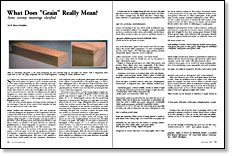
Synopsis: The celebrated wood technologist R. Bruce Hoadley defines more than 70 terms involving specific meanings of the wood grain. They are all the result of two variables: the way the tree grew, and the way it was sawn. The phrases are broken into several categories, grouped by planes, surfaces, and direction; grain and figure; grain and surfacing; and earlywood and latewood.
Seldom can a discussion about wood get far without the use of the word “grain.” Yet grain is such a versatile word that its many accepted meanings are often confusing, and sometimes even contradictory. A woodworker who says “I don’t like the grain of that board” could be talking about any number of things. Most likely, he means the board’s figure, the visual pattern on the board, but he could also be talking about the slope of the grain (too much slope weakens a board), or about the way the board grew in the tree—a luthier, for example, senses that an edge-grained piece of spruce is stiff enough for a guitar top, a flat-grained piece isn’t.
Here are some seventy phrases involving specific meanings of the word grain. They are all the result of two variables: the way the tree grew and the way it was sawn.
Planes, surfaces and direction— “Grain,” first and foremost, commonly designates the alignment of the longitudinal cells that comprise the bulk of wood tissue, as shown above. Grain direction is a better term when used in this sense. We speak of wood splitting along the grain or with the grain, meaning parallel to the fibers; across the grain means generally perpendicular to the fibers. Surfaces cut parallel to the grain direction are called longitudinal grain or simply long grain, as opposed to end grain, which is the surface perpendicular to the fiber direction.
Grain can also refer to the position of the growth rings with respect to both the plane of cut and the appearance produced. For example, a tangential surface—parallel to the growth rings— is said to have tangential grain. This term is also applied to boards whose widest surface has this orientation. Synonymous with tangential grain are flat grain, plain grain and slash grain. If the surface is perpendicular to the growth rings, it is said to have radial grain, that is, the wide face of the board was oriented on a radius of the tree stem. Edge grain, vertical grain and quarter grain are flexible terms, but they all represent grain that is more radial than tangential.
Obviously, boards can be cut with varying degrees of grain orientation. In commercial lumber, flat grain includes boards with growth rings oriented at angles of 0° to 45° to the wide face; edge grain, 45° to 90°. Bastard grain indicates that the growth-ring placement is clearly neither flat grain nor edge grain, but somewhere in the 30° to 60° range. Mixed grain refers to a quantity of lumber that includes assorted edge, flat and bastard grain in any combination.
From Fine Woodworking #52
For the full article, download the PDF below:
Fine Woodworking Recommended Products

Ridgid R4331 Planer

AnchorSeal Log and Lumber End-Grain Sealer

DeWalt 735X Planer






















Log in or create an account to post a comment.
Sign up Log in